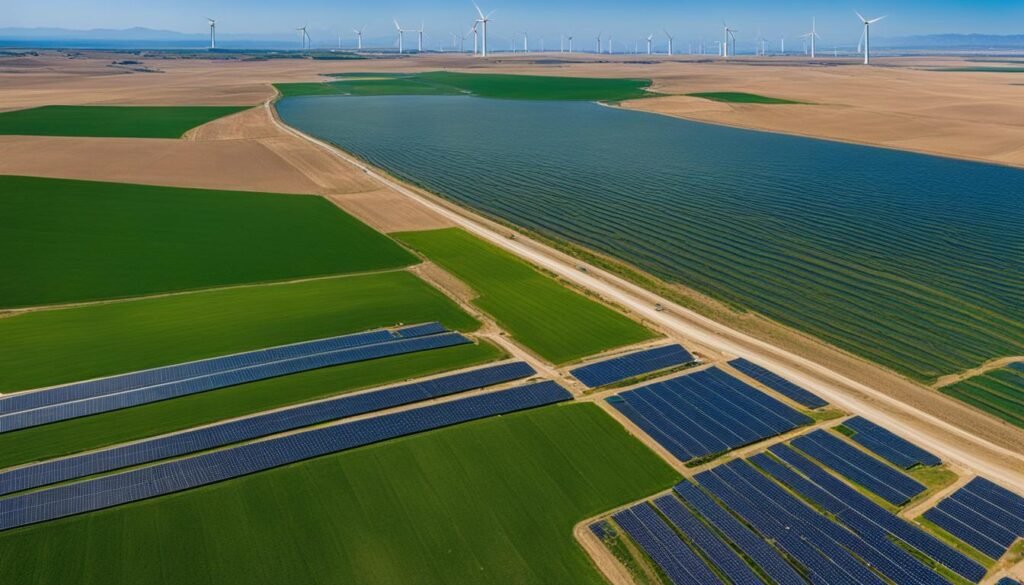Climate change is a pressing issue that affects us all, and California is no exception. The unique climate of this region, combined with the consequences of human activity, has resulted in significant challenges for the state. It’s crucial to understand these challenges and explore the solutions that California is implementing to combat the climate crisis.
Key Takeaways:
- California is facing climate challenges due to changing weather patterns and increased greenhouse gas emissions.
- The state is experiencing the impacts of climate change, including air pollution, deforestation, droughts, heat waves, and sea-level rise.
- California is committed to reducing carbon pollution, increasing energy efficiency, and embracing clean energy and technology.
- Climate change is affecting California’s weather patterns, ecosystems, agriculture, and water resources, requiring adaptation strategies.
- California’s comprehensive climate policy framework encompasses various sectors, prioritizing collaboration, innovation, and sustainable solutions.
The Impact of Climate Change on California
Climate change is having a significant impact on California, with various changes in weather patterns and environmental conditions. These changes are leading to more frequent and severe heat waves, droughts, and wildfires, which pose significant challenges for the state.
Rising temperatures and changing precipitation patterns are disrupting ecosystems, affecting agriculture, and putting pressure on water resources. These changes have far-reaching consequences for the environment and the communities that depend on it.
The increase in greenhouse gas emissions, primarily from human activities, is a major contributor to climate change. It not only intensifies the effects of climate change but also contributes to air pollution, which has adverse health effects on Californians.
Recognizing the urgency of the situation, California has been implementing climate adaptation strategies to address these impacts and protect its natural resources. These strategies focus on building resilience in the face of climate change, safeguarding ecosystems, and ensuring the well-being of communities across the state.
The California Weather Patterns and Greenhouse Gas Emissions
California’s unique geography and climate make it particularly vulnerable to the effects of climate change. The state experiences a range of weather patterns, from coastal fog to hot and arid conditions inland.
However, climate change is magnifying these weather patterns, leading to more extreme and unpredictable conditions. This includes longer and more severe heat waves, prolonged droughts, and an increased risk of wildfires.
The increase in greenhouse gas emissions, primarily from the burning of fossil fuels, is a significant driver of climate change. These emissions trap heat in the atmosphere, leading to higher average temperatures and contributing to the escalating impacts experienced in California.

The Impacts on Ecosystems, Agriculture, and Water Resources
Climate change is disrupting California’s delicate ecosystems and posing challenges for the state’s agriculture and water resources. Rising temperatures and changing precipitation patterns are altering the distribution of plants and animals, threatening biodiversity.
Agriculture, a vital industry in California, is also feeling the effects. Changes in temperature and water availability have consequences for crop yields, putting the state’s food security at risk.
Water resources, already under pressure in California, are further strained by climate change. Prolonged droughts and reduced snowpack influence the availability and quality of water, impacting both urban and rural communities.
Addressing the Impacts: California’s Climate Adaptation Strategies
Recognizing the urgent need to address these impacts, California has implemented various climate adaptation strategies. These strategies aim to protect the state’s natural resources and communities while also fostering resilience in the face of climate change.
- Developing sustainable water management plans to ensure water availability and address drought conditions
- Investing in fire prevention and wildfire management strategies to mitigate the risk and impact of wildfires
- Implementing measures to protect coastal communities from sea-level rise and increased storm events
- Promoting sustainable agriculture practices that are both climate-resilient and environmentally friendly
- Encouraging energy-efficient buildings and transportation to reduce greenhouse gas emissions
- Supporting research and innovation to develop new technologies and strategies for climate adaptation
By prioritizing these adaptation strategies, California is taking proactive steps to address the impact of climate change and build a more resilient and sustainable future for the state.
California’s Climate Action and Solutions
California is at the forefront of addressing climate change and implementing sustainable solutions. The state has set ambitious climate goals aimed at reducing greenhouse gas emissions and creating a cleaner, more resilient future. By targeting net-zero emissions by 2045, California aims to lead the way in combating climate change and protecting the environment for future generations.
To achieve these goals, California has implemented a comprehensive range of climate initiatives and policies. These initiatives focus on promoting clean energy technologies, improving energy efficiency, and transitioning to sustainable transportation systems. By embracing renewable energy sources such as solar and wind power, California is reducing its reliance on fossil fuels and decreasing carbon emissions.
Climate data analysis plays a crucial role in guiding decision-making and informing the development of effective climate solutions. By analyzing climate data, policymakers and researchers can gain valuable insights into the state’s climate patterns and trends. This information allows for the creation of targeted strategies to address the impacts of climate change and develop innovative solutions.
California’s Climate Policy Framework
California’s comprehensive climate policy framework encompasses multiple sectors and promotes collaboration and innovation. The state recognizes the need for partnership between government, businesses, and communities to achieve its climate goals. Through cooperative efforts, California is driving the adoption of sustainable practices and fostering the development of climate solutions.
The state’s forward-thinking approach is evident in its commitment to investing in clean technologies and supporting the growth of clean energy industries. By encouraging the adoption of electric vehicles and advancing energy-efficient building standards, California is leading the way in creating a cleaner and more sustainable future.

Collaboration and Innovation
Collaboration and innovation are key drivers of California’s climate policy. The state actively seeks partnerships with other jurisdictions, organizations, and businesses to share knowledge and best practices. By fostering collaboration, California can accelerate the development and implementation of effective climate solutions.
Furthermore, California’s commitment to innovation is evident in the thriving clean technology sector. The state’s support for research and development is stimulating the creation of cutting-edge climate solutions. From renewable energy advancements to innovative water management techniques, California is spearheading the development of technologies that address the challenges posed by climate change.
- California’s climate action is driven by ambitious goals and initiatives
- Climate data analysis informs decision-making and guides the development of effective solutions
- The state’s comprehensive climate policy framework prioritizes collaboration and innovation
- Partnerships and innovation are crucial in accelerating the implementation of climate solutions
The California Water Plan and Climate Resilience
The California Water Plan plays a crucial role in effectively managing the state’s water resources and addressing the impacts of climate change. With the increasing urgency of the climate crisis, it is essential to develop strategies that promote both water sustainability and climate resilience.
The water plan focuses on strengthening watershed resilience, which involves enhancing the ability of natural systems to adapt to changing environmental conditions. By ensuring the health and functionality of watersheds, California can safeguard its water supply and mitigate the impacts of climate change.
Climate data analysis is a key component in developing climate resilience strategies. By analyzing California’s climate data, experts can identify trends and patterns that help inform decision-making and resource management. This valuable information allows for the development of effective strategies to address long-term water management and prepare for droughts and other climate-related challenges.
Understanding the state’s climate data and weather patterns is also important for visitors planning a trip to California. By accessing climate data and weather forecasts, travelers can choose the best times to visit and make the most of their experience in the Golden State.
Whether you are a resident or a visitor, the California Water Plan and climate resilience efforts are vital for ensuring a sustainable and resilient future. By embracing these strategies, California can navigate the challenges of the changing climate while protecting its precious water resources for generations to come.
The Growing Threat of Extreme Weather Events
Climate change in California is causing a significant increase in extreme weather events, posing a grave threat to the state and its residents. Heat waves, once sporadic occurrences, are now becoming more intense and frequent, leading to serious health risks.
With rising temperatures, California is experiencing prolonged droughts, putting immense strain on agriculture and water supplies. The scarcity of water resources has far-reaching consequences, impacting not only farmers but also the entire state’s economy and food security.
Furthermore, flooding events are becoming more frequent and destructive, causing damage to critical infrastructure and putting communities at risk. These extreme weather events are a direct result of climate change, and their impact is already being felt across California.
It is imperative to address the root causes of climate change and develop strategies to mitigate and adapt to these challenges. Transitioning to clean energy sources, reducing greenhouse gas emissions, and implementing climate resilience plans are essential steps in safeguarding California’s future.
Key Points:
- Heat waves in California are becoming more intense and frequent, posing health risks
- Droughts are impacting agriculture and water supplies, threatening the state’s economy and food security
- Flooding events are occurring more frequently, causing damage to infrastructure and putting communities at risk
- Addressing the root causes of climate change and implementing resilience strategies are crucial for California’s future
As we witness the devastating effects of extreme weather events, it is clear that proactive measures are necessary to protect California’s communities and ensure a sustainable future for generations to come.
Conclusion
California is at the forefront of the climate crisis, facing significant challenges due to changing climate patterns. With a deep understanding of the urgent need for action, the state is taking decisive steps to address these challenges.
Recognizing the importance of reducing greenhouse gas emissions, California is actively transitioning to clean energy sources and implementing innovative climate adaptation strategies. By prioritizing climate action, the state aims to protect its natural resources, communities, and future generations.
However, the journey towards sustainability is ongoing. It requires continued efforts and collaboration from government, businesses, and individuals to achieve lasting and meaningful change. Together, we can forge a resilient future for California, mitigating the impacts of climate change and ensuring a safe and sustainable environment for all.
FAQ
What is the climate like in California?
California has a diverse climate due to its size and geography. The state has a Mediterranean climate along the coast, characterized by mild, wet winters and warm, dry summers. Inland areas experience a more continental climate, with hotter summers and colder winters. The state also has desert regions with hot, arid conditions.
How is climate change affecting California?
Climate change is impacting California in various ways. The state is experiencing more frequent and severe heat waves, droughts, and wildfires. Rising temperatures and changing precipitation patterns are affecting ecosystems, agriculture, and water resources. Greenhouse gas emissions contribute to air pollution and worsen health issues. California is implementing climate adaptation strategies to address these impacts and safeguard natural resources and communities.
What is California doing to address climate change?
California is taking significant action to combat climate change and develop sustainable solutions. The state has set ambitious climate goals, including reducing greenhouse gas emissions to net-zero by 2045. California has implemented initiatives and policies promoting clean energy, energy efficiency, and sustainable transportation. Climate data analysis informs decision-making and guides the development of effective climate solutions. Collaboration and innovation are prioritized within California’s comprehensive climate policy framework.
How does climate change impact water resources in California?
Climate change affects water resources in California by altering precipitation patterns and intensifying droughts. The state’s climate data analysis helps develop climate resilience strategies within the California Water Plan. Understanding weather patterns and climate data is essential for managing water resources and preparing for droughts and other climate-related challenges. Visitors to California can utilize climate data and weather forecasts to plan the best times to visit the state.
What extreme weather events has California been experiencing due to climate change?
Climate change has led to more intense and frequent heat waves, droughts, and flooding events in California. These extreme weather events pose health risks to residents, impact agriculture and water supplies, and damage infrastructure and communities. Addressing the root causes of climate change and developing strategies to mitigate and adapt to these challenges are crucial for California.
What is California doing to address the climate crisis?
California recognizes the urgency of the climate crisis and is taking significant action to address it. The state is committed to reducing greenhouse gas emissions, transitioning to clean energy, and implementing climate adaptation strategies. By prioritizing climate action, California aims to protect its natural resources, communities, and future generations. Continued efforts are needed to achieve sustainable solutions and mitigate the impacts of climate change.







